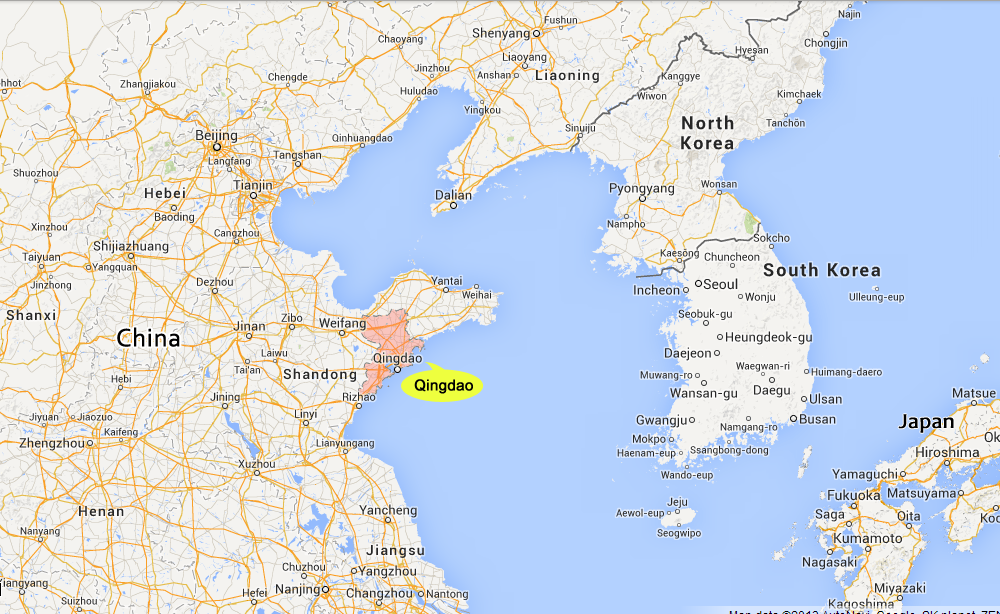About Qingdao
Geographic Location: Qingdao, on the coast of the Yellow Sea, lies in the south of Shandong Peninsula (at 35°35'N ? 37°09'N and 119°30'E ? 121°00'E). It faces the Republic of Korea and Japan across the sea in the east.

Administrative Division: Qingdao currently has seven districts including Shinan, Shibei, Sifang, Licang, Laoshan, Huangdao and Chengyang, and five county-level cities of Jiaonan, Jiaozhou, Jimo, Pingdu and Laixi.
Total Area: Qingdao has a total area of 10,654 square kilometers, 1,159 square kilometers of which is the urban area.
Total Population: Qingdao has a total permanent population of 8.4561 million and a total household registered population of 7.6156 million, in particular, urban permanent population is 3.4745 million and urban household registered population is 2.7625 million.
National Environment: A coastal hilly city, Qingdao has a topographical feature of being high in the east and low in the west, and the ground rises in the south and north sides. Laoshan Mountains in the southeast extends northward to the downtown area. There are underwater bank, modern underwater delta, and marine-erosion plain at the bottom of the shallow sea. Qingdao has twisted coastline dotted with capes and bays. The coastline measures 862.64 kilometers (including the coastlines of islands in its jurisdiction) long, of which the continental coastline totals 730.64 kilometers or one-fourth of the total coastline of Shandong Province. There are 32 bays whose area is larger than 0.5 square kilometers and 69 islands including 10 with settled population.
Climate: A place in the north temperate monsoon region, Qingdao has a temperate monsoon climate. Due to the regulation of marine environment and the effect of southeast monsoon, ocean current and water mass, the urban areas have distinctive features of marine climate: humid air, moderate temperature, no very hot weather in summer and no very cold weather in winter. The average annual rainfall is 662mm; average temperature in summer is 23?, and average temperature in winter is above 0?.
(The diagram of average monthly sunshine hours, temperature, rainfall and evaporation of Qingdao in 2008)
City Tree & City Flower: Qingdao's city tree is cedar; city flowers are camellia japonica and China rose.
Historical Evolution: With a long history, Qingdao has a splendid culture; it is also the cradle of Chinese Taoism.
Qingdao is one of the main places where the Dongyi People lived and procreated in the Neolithic Age over 5,000~6,000 years ago, leaving rich and colorful Dawenkou Culture, Longshan Culture and Yueshi Culture.
In the Zhou and Shang Dynasties, Qingdao became the birthplace of Chinese sea salt, ranking among China's "Four Ancient Salt Zones" and "Five Ancient Harbors". During Spring and Autumn and Warring States Periods, Jimo, the second biggest city in Shandong Province, was established here. The ancient city of Jimo (located in today's Pingdu City) is the earliest of its kind extant in China. King Gou Jian of the Yue State established capital in Langya (located in today's Jiaonan City) and later became the overlord of the State. After unifying China, the First Emperor of the Qin Dynasty (221~206 BC) made inspection tours in his country for five times and personally climbed onto Langya Terrace for three times. According to historical records, Xu Fu also set sail from Qingdao to Korea and Japan when he made the earliest overseas voyage in China. The Emperor Wudi of the Han Dynasty (206 BC~220 AD) once stayed in Buqi (located in today's Chengyang District) as the King of Jiaodong when he was young. He was the emperor who made the most frequent inspections to Qingdao in historical records. In the Tang and Song Dynasties, as a transfer station linking the south and north shipping, Qingdao became the most important transport hub and trading port in north coastal region in China. In the Song Dynasty, Shibosi Department was specially established to manage foreign trade in Banqiao Town (located in today's Jiaozhou City). In the Yuan Dynasty, China's only sea canal, Jiaolai Canal, which ran across Shandong Peninsula was dug for the purpose of convenient sea transportation. During the Ming and Qing Dynasties, Qingdao was an important fortress for coastal defense in northern China and called Jiao'ao by the then people.
On June 14, 1891, the Qing government established garrison in Jiao'ao, which represented the beginning of Qingdao as an administrative division in China. On November 14, 1897, German troops occupied Qingdao under the pretext of the "Juye Religious Incident" and turned Qingdao into a colony, which caused the "Reform Movement of 1898" by reformers in the Qing Dynasty. After World War I broke out in 1914, Japan replaced Germany to occupy Qingdao. The famous "May Fourth Movement" was triggered by the calls for the recovery of Qingdao, which was the watershed of China's contemporary history and China's modern history. On December 10, 1922, Chinese Beiyang government took back Qingdao and transformed it into a commercial port. The Kuomintang government designated Qingdao as a special city in July 1929 and renamed it as Qingdao city in 1930. In January 1938, Japan reoccupied Qingdao. In September 1945, Kuomintang government took over Qingdao and designated it as a special city again.
On June 2, 1949, Qingdao was liberated as the last city in North China and designated under the jurisdiction of Shandong province. Qingdao was designated among China's 15 economic center cities in 1981 and among China;s 14 coastal open cities in 1984. In 1986, Qingdao was listed in the 5 cities specifically designated in the state plan and granted with provincial level authority over economic administration. In 1994, Qingdao became one of China's 15 sub-provincial cities and a famous historical and cultural city in China.
